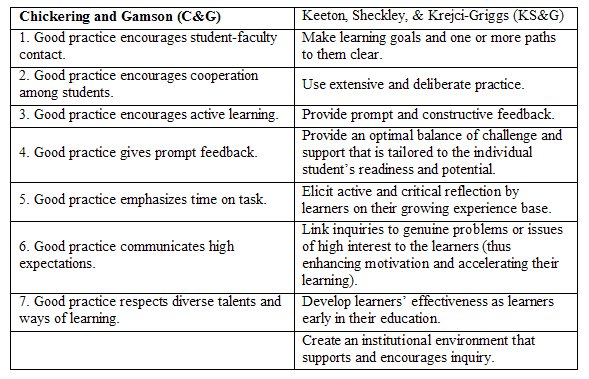|
What are the
differences between Basic Principles and Best
practices? As I looked into these two topics as
independent subject categories, I
discovered that the two tend to blur together. Today's
best practices are tomorrows basic
principles. Teaching
online is new to most educators. The short history of
online instruction is marked by pioneers who have
tried a
little of this with a little of that, a sort of trial
by fire, if you will.
What
follows are various opinions expressed in three
articles on what are the best practices
and principles of online education. The following
sources are particularly effective in simplifying
the issues in regard to successful practices. I have
only included excerpts from the articles. If
you would like to view the entire article, at the
end of each article is a link to the original
document. Also included
beneath each article is a link to a printer friendly
PDF version.
NOTE: A
more extensive selection of links to articles can be found under the Resources
link on left-hand menu bar.
*PDF Documents require the Adobe
Acrobat Reader
Best Practices and
principles of online education from Weber State
Best Practices
from University of Maryland study
Why
Encourage Student Interaction and Collaboration?
Best
Practices and principles of online education from Weber State
Weber
State University (WSU) faculty believe that the
following 18 points need to be included in any
successful Online Course:
1.
An online course should be based on the same
learning outcomes and demand the same rigor as a
traditional class. The identification of courses to
be taught online, the semesters in which to offer
them, and the assignment of instructors rest with
the academic department.
2.
Students should spend the same amount of time on an
online course as they do for a campus course. The
rule of 15 clock hours of class time per credit hour
should guide development of an online course.
3.
Online courses should reach the same learning
outcomes as traditional courses. Assessment of the
effectiveness of online offerings should be
conducted at the same time as and in a manner
consistent with departmental standards and practice
for traditional courses.
4.
Online faculty are responsible for identifying
copyrighted materials used in their courses and for
either citing that material appropriately or
obtaining written permission to use it in the web
environment in advance of coursework beginning.
5.
Discussions, chat, use of media (especially streamed
media) should all be chosen to be value-added to the
student.
6.
Every course should address the needs of students
with disabilities; boilerplate language can be
provided.
COURSE
COMPONENTS
7.
All online courses use the course template
(which includes navigation pathways and design
standards) developed by the WSU Online team and
modified by the experience of WSU Online faculty.
8.
Course content should be up-to-date at the beginning
of the term, with dates changed from term to term
and links updated.
9.
Because online courses are unique in being a form of
publication, experienced online faculty feel that
each course must reflect the highest professional
standards, including careful attention to such
fundamentals as spelling, grammar, and mechanics.
Comment:
Even though access to courses is restricted to
enrolled students, posting material to the world
wide web is a form of publication that reflects not
only on the individual faculty member but also on
the institution as a whole. Errors can be magnified
and multiplied in the online environment. The
standard stated here addresses the instructor’s
work. Each instructor may set and should articulate
his own standard for the level of editing expected
in student work.
If
the instructor views web assignments as written work
to be graded on mechanics as well as content, that
should be clearly stated. If the instructor is more
concerned that students make substantive content
contributions to an online discussion without
worrying about spelling (for instance), that too
should be clearly stated.
10.
When possible and when supportive of course
objectives, the course should draw on and
incorporate some of the vast information resources
available via the web.
11.
Instructors should feel free to use library
resources to the same extent for online courses as
they do in traditional classes.
12.
There should be task submissions for students with
substantive feedback on a regular basis, preferably
weekly.
13.
Online instructors should set and articulate clear
and realistic timelines for responding to students
and should adhere to them.
14.
Special efforts should be made to create and support
a learning community among online students who may
feel they are working in isolation.
15.
The course should use the richness of the electronic
medium to the fullest extent possible. Online
faculty should possess skills in word processing and
electronic communication at least equivalent to
those identified in the computer literacy
requirement for students.
16.
Course design should include appropriate orientation
about how the course is structured and how online
tools work.
17.
The online medium should be used for teaching and
learning activities. A syllabus and a set of online
tests do not constitute an online course.
18.
Every course should address academic honesty.
December
17, 2000
Weber
state article pdf
For
more information, the actual article is located at:
http://wsuonline.weber.edu/factraining/unit1/section1/guidelines.htm
#1.
Weber
State Article Question:
If you were to rate the top 3 points (out of the 18
points sited in the article), what would they be?
Explain why you feel these three points that you
selected are very important.
Back to Top
Best
practices from University of Maryland study
This
study examines how best practices in online
instruction are the same as, or different from, best
practices in face-to-face (F2F) instruction. The
book Effectiveness and Efficiency in Higher
Education for Adults [1]
summarizes some 20 years of research on best
practices in F2F instruction. The bases of
comparison are principles from the KS&G material
and from Chickering and Gamson’s “seven
principles for good practice in undergraduate
education” [2].
A reason for making these comparisons is that the
rapid growth of online instruction promises that
online instruction may become the largest source of
ongoing higher education. Not surprisingly, interest
in assessing the quality of online offerings has
also grown [3,
4,
5,
6].
The question is increasingly raised: Are
postsecondary institutions effectively “doing
their old job in a new way?” [7].
One way to answer that question is to analyze the
online instructional practices of faculty with the
aid of research on patterns of instruction,
face-to-face and online.
I.
PRINCIPLES OF BEST PRACTICE
The
book Effectiveness and Efficiency in Higher
Education for Adults [1]
(herein referred to as KS&G) undertakes just
such an analysis. The book surveys research of the
last 20 years, including meta-analyses of studies on
different principles of instruction, in search of
principles and practices with largest effect sizes
in explaining learning gains. Eight principles
emerge as a manageable set of principles meeting
this criterion. For each of the principles, case
studies are cited that apply each principle as
effective practices or strategies.
These
eight principles, though worded differently,
partially overlap and supplement the “seven
principles for good practice in undergraduate
education” [2]
(herein “C&G”).
Table
1. Principles from C&G and from KS&G

A focus
on active learning is shared by the two analyses,
with KS&G making explicit the need for critical
thinking and including cooperation among students
and interaction between teacher and students as ways
to foster the active, critical reflection. Finally,
KS&G adds a focus on the institutional climate
or environmental press for inquiry as a key to best
practice.
II.
KEY FINDINGS
Key
findings of the study to date include the following:
- The individual instructor’s effectiveness in
applying the eight principles of KS&G is a
major factor in adult students’ learning and
persistence.
- Students need support additional to that of the
syllabus in understanding and pursuing the
learning objectives of a course or other
educational effort.
- Students in online courses expect faculty to be
more readily and promptly available at non-class
times than F2F students expect of faculty in
responding to the students’ communications.
- The most effective faculty actively use five or
more of the full array of instructional
principles so can they elicit the largest
learning effects.
- Faculty agreed that teaching well online is
more time-consuming than teaching F2F.
February 14,
2002
University of Maryland study pdf
For
more information, the actual article is located at:
http://www.sloan-c.org/publications/jaln/v8n2/v8n2_keeton.asp
#2. University
of Maryland Study Question:
Relate an experience you have had with an excellent
F2F instructor and respond to these two questions:
What made that instructor great? How would that
great instructor continue to be great in an online
environment?
Back to Top
Why Encourage Student Interaction and Collaboration?
Online course
communication tools enable students to interact with
course content, the instructor, and their peers outside of
the classroom. Students are given the opportunity to
negotiate the meaning of course content through
these interactions - creating the potential for a
deeper and longer lasting learning.
A virtual
learning community that provides support and sharing
among its members can be built through the integration of
online communication tools and course activities and
sustained through effective facilitation by the
instructor.
Fundamental principles of
constructivism support this view: learning is an
active process of constructing rather than acquiring
knowledge individuals learn through interaction with
their world individuals develop knowledge through
social interaction.
Changing
Roles in Online Learning Environments
Instructor
Role:
|
Face
to Face |
Online |
| -from lecturer
-from provider of answers
-from provider of content
-from total control of the teaching
environment
-from teacher-directed |
-to guide and resource
provider
-to expert questioner
-to designer of student learning
experiences
-to sharing with the student as a fellow
learner
-to learner centered |
Source:
Berge, Collins, 1996
Learner Role: towards
more collaborative/cooperative interaction with
peers
Learner
Role:
|
Face
to Face |
Online |
| -from
passive receptacles
-from memorizers of
facts
-from passive
learning |
-to
constructors of their own knowledge
-to problem-solvers
-to
active learning |
Source:
Berge, Collins, 1996
Certain
researchers suggest that a teaching method which
encapsulates collaboration and interaction would
likely work well within the framework of Internet
based distance education courses. In order to verify
how interaction and collaboration work between
students in distance education courses, we observed
and researched two undergraduate university courses
offered via the Internet. All communications were
text based and in asynchronous mode relying upon
e-mail, group discussions and hypertext navigation
to facilitate the collaborative work process. This
exploratory study has enabled us to identify some
problematic elements which can hamper collaboration
between distance education students. From these
results, we developed recommendations for ensuring
the success of collaborative assignments for future
Internet courses.
From what we have observed and analyzed,
the following recommendations have been compiled in
order to ensure optimal conditions for collaboration
via the Internet :
- Collaborative tasks should be an integral
element of the course design and should be
offered at regular intervals. As much as
possible, collaborative tasks have to be
evaluated on equal par with individual work.
- Distance learners should be encouraged to
construct learning together through meaningful
collaborative tasks which allow for pertinent
interaction. These collaborative tasks must be
based upon a constructivist approach rather than
a transmission type approach.
- Group composition has to be undertaken with
great care by attempting to match personal,
professional, cultural and academic backgrounds.
- It is necessary to indicate that collaboration
via the Internet did not work well within the
parameters of first year courses, which attracts
a multitude of students with diverse academic
backgrounds. Research has shown that
collaboration works well with a professional or
graduate course where the level of homogeneity
among students is much higher (Muffoletto,
1997).
March 3, 2000
Interaction and Collaboration pdf
For
more information, the two actual articles are located at:
http://www.cmu.edu/teaching/technology/bestpractices.html
http://ifets.ieee.org/periodical/vol_3_2000/d11.html
#3. Student Interaction and
Collaboration Question:
As a group in a threaded discussion, discus the
following problem: If you were an online instructor,
how would you get students to interact and
collaborate?
Back to Top
|


